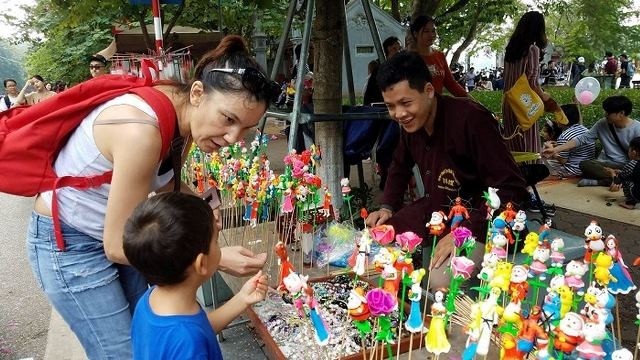Blending tradition in contemporary life
Every weekend at the pedestrian space around Hoan Kiem Lake, a stall of artisan Dang Van Hau, from Xuan La village, Phu Xuyen district, Hanoi, which is famous for the craft of making ‘to he’ (toy figurines made from glutinous rice powder), welcomes many domestic and foreign visitors.
Despite being a time-honoured heritage with unique value, the craft is facing a high risk of falling into oblivion. To revitalise his ancestors’ craft in contemporary life, Hau worked with researcher Trinh Bach to revive many samples of typical ‘to he’, including a collection of ‘to he’ for Mid-autumn festival.
Hau has also worked out new ‘to he’ samples. Upon the lunar New Year 2019 – the Year of the Pig, he created a number of ‘to he’ shaped as pigs, which were featured in Dong Ho and Kim Hoang folk paintings.
This year’s Mid-autumn festival, he is preparing for new ‘to he’ samples in the shapes of lanterns, which were inspired from the two above-mentioned genres of folk paintings.
In a similar effort to retrieve the glory of ancient culture in contemporary life, artisans from Bien Hoa pottery village in Dong Nai province have produced pig-shaped ceramic products, which were adapted from Kim Hoang folk paintings.
There is also the involvement of young people, including members of the Hoa Van Dai Viet (Patterns of Great Viet) project, which digitises 250 ancient Vietnamese decorative patterns in order to apply them to a wide a variety of products; ‘Hoa Sac Viet’ (Vietnamese Colours and Patterns) project, which arranges and digitalises typical colours and patterns seen in Hang Trong folk paintings and then adapts them in various designs and products; and ‘Ve Lai Tranh Dong Ho’ (Redrawing Dong Ho paintings) by painter Nguyen Xuan Lam, which recreates Dong Ho folk paintings using graphic techniques; among others.
These projects present a new way of looking at traditional culture from the contemporary lens in order to promote the heritages in modern life.
 |
Selected products from Hoa Sac Viet’ (Vietnamese Colours and Patterns) project, which digitalises typical colours and patterns seen in Hang Trong folk paintings
An inevitable trend
According to artisan Dang Van Hau, utilising and applying traditional materials in the creation of cultural products, particularly his ‘to he’ samples, is a sound direction which has earned enthusiastic welcome from customers.
He revealed that his new ‘to he’ products, which were inspired from folk paintings or folk tales, have drawn much attraction from foreigners. Targeting children, Hau creates ‘to he’ in shapes cartoon characters, such as superheroes, Queen Elsa and Doraemon, to attract their interest.
Meanwhile, while working on a project on revitalising Kim Hoang folk paintings, collector Nguyen Thi Thu Hoa and her partners have not only restored once-famous Kim Hoang paintings but have also created new decorative patterns, which were inspired from those seen at the Kim Hoang village’s communal house in Van Canh commune, Hoai Duc district, Hanoi.
On the occasion of lunar New Year 2019 – the Year of the Pig, the project team also coordinated with silver craftsmen from Dinh Cong village in Hanoi to produce decorative silver pigs.
Hoa said that apart from preservation efforts, innovative initiatives are needed to promote folk paintings in contemporary life and win public support for the project.
It is true that creative practices that turn traditional culture-inspired ideas into applicable products have not only contributed to promoting the country’s heritages but have also created new value for the heritages themselves.
To date, it can be affirmed that there is a clear trend of creating products based on traditional values. It is very encouraging since it helps to bring the aged-old heritage closer to contemporary life and pervade the country’s cultural value in the community.
















